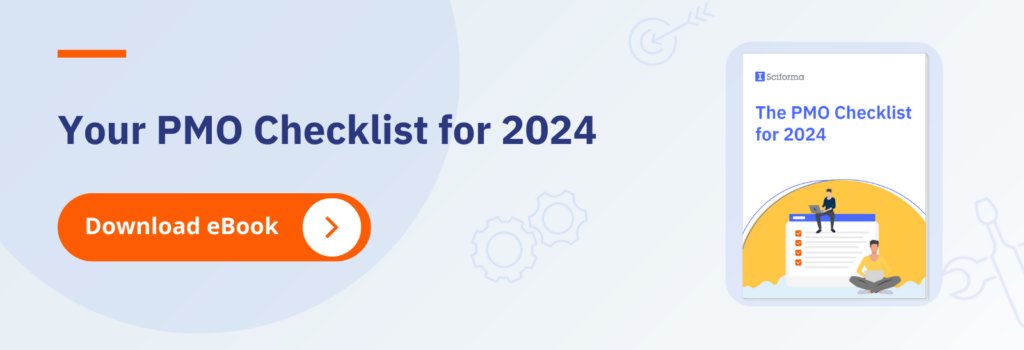- Home
- Blog Center
- Becoming the PMO of the Future: 5 Modern PMO Success Factors
Becoming the PMO of the Future: 5 Modern PMO Success Factors
Your PMO is essential when it comes to positioning your company towards the future. And the days when a great track record of on-time, on-budget, and within scope was organizations’ primary concern are over. Now, that’s table stakes: the PMO is the engine of corporate change, and corporate change is the lifeblood of a business. So let’s discuss the key success factors to position your PMO for the future.
#1 PMO Success Factor: Focus on “Next Practices” for the Future
Companies rightly leverage institutional and industry learnings that have been acknowledged and generally accepted as best practices. But best practices will have diminishing applicability moving forward. This is because best practices are about what has worked in the past and applying it to the present. The accelerating speed of business disruption requires future-oriented PMOs companies to look into a future that is increasingly unforeseeable.
Business models are being fundamentally redefined by an array of technologies including AI and IoT. Best practices for the development, delivery, and operationalization of these technologies have not had time to emerge. The term Next Practices has therefore surfaced to fill this gap. For now, just think of this as code for “what culture, skills, and competencies do we need to have in place in order to harness and leverage the power of these disruptive technologies?” Best practices are driven by experience (reflecting on the past). But next practices will necessarily be driven by anticipation (predicting the future). Here their importance for the future of the PMO.
#2 PMO Success Factor: Nurture your Business Alliances
You have worked hard to establish your PMO as a vital entity with business stakeholders and the project community. But you can’t rest on your laurels.
It is critical for the future of the PMO that its leadership continues spending time with business sponsors and champions. Continue to cultivate that relationship! Does your steering committee still have active participation from designated C-level and line of business executives? Is there an unambiguous business sponsor or champion assigned to all the large, complex, and transformational projects? Make it a regular priority to sit down proactively with your business allies to understand strategic priorities moving forward rather than reporting out on what happened looking backward. Have an on-going discussion about the role of disruptive technologies, digitalization, and business transformation initiatives. This is key to future-proof your PMO.
#3 PMO Success Factor: Drive Strategy Execution into the Future
PMOs are most valuable when they are driving business strategy execution. That is, programs and projects are executed to implement a business priority or objective. For example, support a new strategic service, deliver a new product, implement a transformational initiative, digitalize a mission-critical process. This “top-down” work should be prioritized over project demand that is justified in part by “bottom-up” strategy alignment. Just because a project aligns with a key business strategy doesn’t mean it provides value. In fact, sometimes frivolous connections between project proposals and business strategies are made to justify pet projects.
On the other hand, projects ideated out of the necessity to deliver on a strategic objective are business critical. If the preponderance of your portfolio is trending more and more towards strategy execution work (versus strategy aligned work), you will continue to build long-term PMO brand value. Thereby paving the way for the success of your PMO in the future.
#4 PMO Success Factor: Embrace Disruption
The interrupt driven world is the new normal. This might require an attitude adjustment and some potential retooling of your people, processes, and technologies. The goal is reestablishing agility and flexibility to prepare your PMO for the future. This is the only truly durable competitive advantage. Whoever is nimbler and adapts faster to opportunity or responds quick to threats will survive and thrive. Is disruption viewed as a threat or an opportunity? Make the necessary adjustments in your environment to ensure change is welcome and fuel for differentiation and not indigestion.
#5 PMO Success Factor: Evolve your Talent Pool
Due to the pace of the aforementioned business change, PMOs should continually refresh skills, affinities, competencies. This is driven by geopolitical and demographic shifts, climate change, mergers, financial and regulatory circumstances, disruptive technologies, and more. Traditional project management skills are less important than investment defined in terms of initiatives, programs, and portfolios. This includes:
- business management and strategic thinking to deal increasingly with executive level stakeholders and metrics
- collaboration and leadership to drive change and transformation within the project organizations and across the business
- expertise in emerging technologies like advanced analytics, AI, and IoT
To ensure your PMO’s future success, audit your portfolio and put a plan in place to fill gaps proactively. And while you’re at it, check out our webinar with industry thought leader, Andy Jordan, on building the next level of PMO: The Strategic Path from PMO to EPMO!






